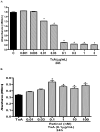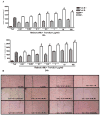Role of retinol in protecting epithelial cell damage induced by Clostridium difficile toxin A
- PMID: 17825865
- PMCID: PMC2268866
- DOI: 10.1016/j.toxicon.2007.07.010
Role of retinol in protecting epithelial cell damage induced by Clostridium difficile toxin A
Abstract
Vitamin A (retinol), a fat-soluble vitamin, is an essential nutrient for the normal functioning of the visual system, epithelial cell integrity and growth, immunity, and reproduction. Our group has investigated the effect of high doses of oral vitamin A on early childhood diarrhea in our prospective community-based studies from Northeast Brazil and found a beneficial role in reducing the mean duration but not incidence of diarrheal episodes. In this study, we explored the role of retinol supplementation in intestinal cell lines following Clostridium difficile toxin A (TxA) challenge. C. difficile is the most common anaerobic pathogen borne with antibiotic-borne diarrhea and pseudomembranous colitis. Since retinol is critical for the integrity of tight junctions and to modulate the cell cycle, we have focused on changes in transepithelial electrical resistance (TEER) in Caco-2, a more differentiated intestinal cell line, and on models of cell proliferation, migration and viability in IEC-6 cells, an undifferentiated crypt cell line, following TxA injury. In this model, retinol therapy reduced apoptosis, improved cell migration and proliferation, and prevented the reduction in TEER, following C. difficile TxA challenge in a glutamine-free medium. These results suggest the role of retinol in protecting intestinal epithelial barrier function from C. difficile TxA enterotoxic damage.
Figures







Similar articles
-
Clostridium difficile toxin A induces intestinal epithelial cell apoptosis and damage: role of Gln and Ala-Gln in toxin A effects.Dig Dis Sci. 2005 Jul;50(7):1271-8. doi: 10.1007/s10620-005-2771-x. Dig Dis Sci. 2005. PMID: 16047471
-
Clostridioides difficile toxin A-mediated Caco-2 cell barrier damage was attenuated by insect-derived fractions and corresponded to increased gene transcription of cell junctional and proliferation proteins.Food Funct. 2021 Oct 4;12(19):9248-9260. doi: 10.1039/d1fo00673h. Food Funct. 2021. PMID: 34606540
-
Theodore E. Woodward Award. How bacterial enterotoxins work: insights from in vivo studies.Trans Am Clin Climatol Assoc. 2002;113:167-80; discussion 180-1. Trans Am Clin Climatol Assoc. 2002. PMID: 12053708 Free PMC article. Review.
-
Essential role of toxin A in C. difficile 027 and reference strain supernatant-mediated disruption of Caco-2 intestinal epithelial barrier function.Clin Exp Immunol. 2008 Sep;153(3):439-47. doi: 10.1111/j.1365-2249.2008.03690.x. Epub 2008 May 26. Clin Exp Immunol. 2008. PMID: 18505424 Free PMC article.
-
Clostridium difficile Toxin Biology.Annu Rev Microbiol. 2017 Sep 8;71:281-307. doi: 10.1146/annurev-micro-090816-093458. Epub 2017 Jun 28. Annu Rev Microbiol. 2017. PMID: 28657883 Review.
Cited by
-
Micronutrient Improvement of Epithelial Barrier Function in Various Disease States: A Case for Adjuvant Therapy.Int J Mol Sci. 2022 Mar 10;23(6):2995. doi: 10.3390/ijms23062995. Int J Mol Sci. 2022. PMID: 35328419 Free PMC article. Review.
-
A leaky human colon model reveals uncoupled apical/basal cytotoxicity in early Clostridioides difficile toxin exposure.Am J Physiol Gastrointest Liver Physiol. 2023 Apr 1;324(4):G262-G280. doi: 10.1152/ajpgi.00251.2022. Epub 2023 Feb 7. Am J Physiol Gastrointest Liver Physiol. 2023. PMID: 36749911 Free PMC article.
-
Nutritional Keys for Intestinal Barrier Modulation.Front Immunol. 2015 Dec 7;6:612. doi: 10.3389/fimmu.2015.00612. eCollection 2015. Front Immunol. 2015. PMID: 26697008 Free PMC article. Review.
-
Clostridium difficile Infection and the Tangled Web of Interactions Among Host, Pathogen, and Microbiota.Gastroenterology. 2018 May;154(6):1573-1576. doi: 10.1053/j.gastro.2018.03.036. Epub 2018 Mar 28. Gastroenterology. 2018. PMID: 29601830 Free PMC article. No abstract available.
-
Tight junctions: from molecules to gastrointestinal diseases.Tissue Barriers. 2023 Apr 3;11(2):2077620. doi: 10.1080/21688370.2022.2077620. Epub 2022 May 27. Tissue Barriers. 2023. PMID: 35621376 Free PMC article.
References
-
- Baltes S, Nau H, Lampen A. All-trans retinoic acid enhances differentiation and influences permeability of intestinal Caco-2 cells under serum-free conditions. Dev Growth Differ. 2004;46(6):503–514. - PubMed
-
- Barreto ML, Santos LM, Assis AM, Araujo MP, Farenzena GG, Santos PA, Fiaccone RL. Effect of vitamin A supplementation on diarrhoea and acute lower-respiratory-tract infections in young children in Brazil. Lancet. 1994;344(8917):228–231. - PubMed
-
- Bartlett JG, Taylor NS, Chang T, Dzink J. Clinical and laboratory observations in Clostridium difficile colitis. Am J Clin Nutr. 1980;33 11:2521–2526. - PubMed
-
- Beyzadeoglu M, Balkan M, Demiriz M, Tibet H, Dirican B, Oner K, Pak Y. Protective effect of vitamin A on acute radiation injury in the small intestine. Radiat Med. 1997;15(1):1–5. - PubMed
-
- Blomhoff R, Blomhoff HK. Overview of retinoid metabolism and function. J Neurobiol. 2006;66(7):606–630. - PubMed
Publication types
MeSH terms
Substances
Grants and funding
LinkOut - more resources
Full Text Sources
Medical

